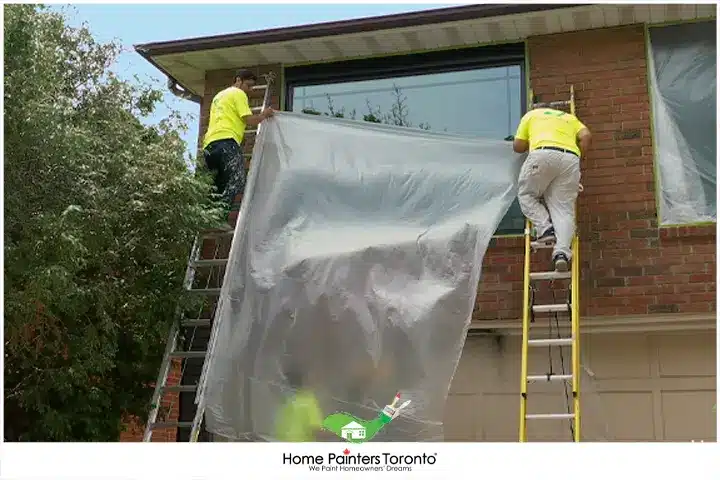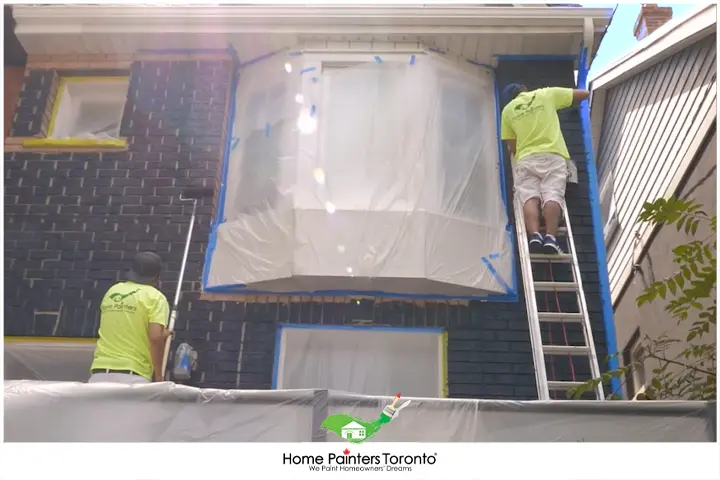
If you want to paint the outside of your home but aren’t sure how to prepare the exterior of your house for painting, you might want to read this article first.
When planning on painting your home’s exterior, preparation is the key to success. It can make the difference between your paint job lasting a decade versus 1-2 years. If you don’t prepare properly, you can look forward to spending more money and time to fix problems that could have been avoided with patience and knowledge.
Preparing House for Painting Exterior
Whether you’re painting the exterior of your home, or want to give your house a fresh look, here’s a quick guide to prepping a house for paint:
1. Clean the Exterior of Your Home
Before painting, it’s important to ensure that your house’s exterior is clean and free from dirt and debris. If any spots on your walls need scraping or sanding, do it now. And then repaint those areas after you’ve finished all other prep work.

2. Cover Any Painted Surfaces with Plastic Film
If you have wooden decking on your porch or patio, cover these surfaces with plastic film before painting them so they are not damaged by paint fumes during application (see below). You can also use plastic wraps over hardware such as hinges and handles; this prevents damage when handling tools during installation.
3. Prepare Tools for Painting
Ensure all the needed materials are in good shape and ready for use. If they’re not, you might be wasting time painting without being able to get the job done right!
If you don’t have all the supplies necessary for painting your house, then it’s best to research how much each item costs and how much time it will take to get them all together. Once you’ve finished everything, it’s time to start the painting process!
Exterior Painting Preparation Tips
- Walk around your house with a notepad and fully assess what needs to be done. You might think you only need to do the trim or the siding, but it is best to do it all at once. It will look better when it is all freshly painted. It also makes sense to tackle all the issues at once.
- Plan with your paint colour choices and finish types. Take measurements to the best of your ability to determine how much of each you need. Talk to a paint specialist to determine the paint you will need. Remember that if you paint over aluminum siding, avoid latex paint at all costs. It will react with the siding and cause issues with the paint.
- Look ahead at the weather to help you decide when the best time will be to get started. Fall is the best month for exterior house painting, with temperatures between 10-25 degrees Celsius optimal.
- If you have shutters, remove them to paint. Clean them and repair them as you would your siding. Paint them separately. Remember that dark paint absorbs heat, which may cause your shutters to warp in the long run.

Preparations Steps To Paint Your Home’s Exterior
Clean Up and Remove Junk
- Remove any clutter or objects that are situated around your home. Make sure to cover any landscaping that is around your house.
- Clean a small, inconspicuous spot on your siding and do a test run with sample primer and paint. This will help you check to ensure no adherence issues and that the paint is compatible.
- Clean, clean, clean. Rent a pressure washer to help you remove dirt and chalk. If you have mould and mildew or stains, you will likely need to use TSP (trisodium phosphate) to clean your siding thoroughly. Make sure to rinse well afterwards and give your house a few days to dry before you move on to any repair work. Depending on the stains, you may need to prime and seal them before you can move on.
- Set up ladders or scaffolding (you can rent it). Scaffolding is the better and safer option.
Repair everything you can
- If you have any repair work that needs to be done, follow up with it. Tighten up or reattach any loose siding or replace if necessary. This is especially important with wood rot. If there are any leaking issues around windows or the roof, consider installing flashing to help prevent further damage. Caulking will help but won’t protect from heavy rain and ice. Replace any damaged or missing caulking and putty windows that need it. If you have wood siding, you will need wood filler or putty to fill holes and gouges. Any patches need to be primed and sealed before you move on.
- For steel or aluminum siding, rust and corrosion must be removed with steel wool or sandpaper. Bare steel needs to be primed right away.
- Lay down and attach extra tarps to catch paint chips and debris. Scrape and sand loose and peeling paint. If you are dealing with a house painted before 1978, wear a ventilation mask and be careful. Chances are the paint has lead in it. You will need a wire brush for this task if you have rough wood siding or painted brick. Clean up and wash any dust and lose paint chips before you move on to priming.
The Right Primer for the Exterior of Your Home
The type of siding on your home will determine the type of primer you use. Primer is important for a number of reasons:
- Stain blocking
- Improves adherence of paint
- Creates a smooth surface
- Reduces the number of paint coats needed
- Seals and protects
Picking the Right Exterior Paint
Oil, latex, acrylic, and alkyd are just a few of the many options for exterior paint. Primer and stain are two further considerations. Despite the lengthy drying time, oil paint remains popular among many artists.
Exterior latex (or acrylic) paint has a water-soluble base and can be easily cleaned off after use. Protected from peeling and breaking, latex paint is another excellent choice for the long term. Additionally, it can be quickly dried after being cleaned with soap and water. The decreasing toxicity of alkyd-modified latex makes it ideal for use on the exterior of a house.
If you thoroughly clean and prepare exterior walls before painting, it doesn’t matter what kind of paint you use for the exterior. In a flat or low sheen, the Regal Select Exterior by Benjamin Moore is our go-to recommendation for painting aluminum siding. If you prefer that brand, you could also use Sherwin-Williams’ Low Sheen paint.
In general, latex primer will do the job. It works well for both interior and exterior and blocks stains. A Shellac primer will block both if you are dealing with tough stains and odours (possibly from a fire or smoke damage). For wood, there is both oil-based and latex wood primer. Oil-based is the best for bare wood surfaces and seals and protects. Latex is better for previously painted surfaces. Finally, a masonry-specific primer for brick, concrete, stucco and plaster exists.
When it comes to painting the exterior of your home, you want to ensure that you are preparing for the job properly so that you can ensure the paint lasts a long time.
Exterior Painting
More interesting blogs related to
“HOW TO PREPARE YOUR HOUSE FOR PAINTING THE EXTERIOR”
If the work involved in Preparing Home for Painting sounds like it involves too much time and energy to do yourself, call 416.494.9095 or email [email protected] for a FREE quote or visit our website. And don’t forget to follow us on all our social channels below!





